WP_Post Object
(
[ID] => 2978
[post_author] => 7
[post_date] => 2019-06-03 17:09:32
[post_date_gmt] => 2019-06-03 23:09:32
[post_content] =>
Emilia Becker doesn’t remember the moment of impact. One instant, she was riding in the school bus, and the next, she was being driven to the hospital. Everything looked white. Later she was told that when the bus collided with another vehicle and flipped over, she hit her head on the roof. She was originally diagnosed with a concussion, but after several weeks of no improvement, it became clear that she had suffered a moderate brain injury. She was only 11 years old.
Physically, the injury left her dizzy and in pain, making walking difficult. “I knew in my head how to walk, but my right leg didn’t listen to me very well. It would drag and my toes would turn in and curl up,” she says.

Becker and one of her strongest supports, her mother Heather Getz. (Photo by Trevor Hopkin)
Then there were the changes in her personality. Her mother, Heather Getz, noticed it right away. “She was very literal. She behaved quite childlike; she was like a three-year-old. One of the biggest things was that she lost her sense of humour,” she says.
Getz took a year off work to get Becker to physio appointments and do whatever she could to help her daughter heal physically and mentally. Cross-country skiing and swimming assisted with mobility, and tricks such as drawing pictures and making up stories helped with memory. “I used to rub her feet, because the right side was impacted. Her right foot was always colder and didn’t have as much sensation. I would try to remind her brain that it was there. I thought if I could remind the brain that those parts are there, maybe they will work better,” Getz says.
"What I’ve learned is that you grieve the change when a child is injured, particularly with brain injury, but it’s the same with any child as they grow up. Who they are may not be what you anticipated, but you have to love them and not push them back into something you thought they would be, because who they’re turning into is remarkable.”
Particularly concerning was when the pediatric neurologist told Getz to be prepared for the possibility that Becker may never be able to live independently. “That was really shocking, because I kept thinking she was getting better. It hadn’t occurred to me that I wouldn’t get my old girl back,” Getz says. “It was hard to accept that we had to let go of the girl she had been, grieve who she was and accept who she is. What I’ve learned is that you grieve the change when a child is injured, particularly with brain injury, but it’s the same with any child as they grow up. Who they are may not be what you anticipated, but you have to love them and not push them back into something you thought they would be, because who they’re turning into is remarkable.”
Returning to school was a struggle for Becker. Before the injury, she had straight As and was involved in Girl Guides, tap, jazz, ballet, Spanish lessons and more. Afterward, she couldn’t even remember how to read or do math. “I’d read a sentence and would forget the beginning of it by the end of the sentence. I went back to reading kids’ [picture] books,” Becker says.

Becker and her fiancé, Sebastian Wolfmueller, take a break from studying. (Photo by Trevor Hopkin)
Getz made flash cards to help Becker learn simple math again. “She cried because she knew how to do things like multiplication but had to relearn it the second time,” Getz says.
All of that hard work paid off. By the end of Grade 8, Becker had one of the highest average in her class. “It wasn’t an option for me to not be the best I could be. I was always a really determined kid. It didn’t occur to me to just accept it. My family really believed in me and sacrificed a lot to get me back to where I was. Without their support, I wouldn’t have been able to do all the rehab that I did,” she says.
Brain injuries are permanent, however. Becker still suffers effects from her injury, including exhaustion and mental health issues such as depression and anxiety. Despite these challenges, Becker enrolled at the University of Victoria in 2013, where she studied sociology for two years.
“I’ve always been ambitious academically, and they knew that the future I wanted had to be achieved by going back to university,” she says. “They believed in me, helped me figure out my finances and really inspired me to take the plunge. I may have gone back eventually on my own, but they were a huge factor.”
When she came home to Regina for the summer in 2015, she contracted a virus that left her bedridden for months. That time off made her realize how much her mental health had been taxed during her time away at university. “Up until then, I’d been coping, but with the added stress of accommodations, living away from home, school and my mental health, I decided it would be the healthiest decision to stay home, near family and friends, and take a break from the stress of school,” she says.
She kept busy working a few different jobs, including with the federal government, Laser Quest, a gym and the Regina Bypass. She also volunteered with CC RezQs, a local dog rescue, by fostering dogs in her home, and she started painting as a hobby. She soon became dissatisfied with the entry-level positions she could find without a university degree. Her mother and boyfriend (now fiancé) started nudging her to go back to school.
“I’ve always been ambitious academically, and they knew that the future I wanted had to be achieved by going back to university,” she says. “They believed in me, helped me figure out my finances and really inspired me to take the plunge. I may have gone back eventually on my own, but they were a huge factor.”
“I may take longer to write a test, but when I put my mind to it, I can still get 90s. I believe that disabilities just change the way we do things but don’t limit us.”
She picked up her studies at the University of Regina in fall 2017. The University was a natural choice for Becker, as she wanted to be close to her family and support systems. She also appreciated the diversity of classes available. She majored in sociology and minored in psychology, filling her electives with classes such as women and gender studies, biology, Cree, and interdisciplinary studies.
The University works hard to accommodate students with disabilities. The main accommodation Becker received was extra time to write exams, as well as a private room to write them in. “The extra time lets me take rests when my brain gets tired, without sacrificing the entire exam,” she says. Becker finds that after about half an hour on a multiple choice exam, she may be unable to comprehend what she’s reading. “It feels like I hit a wall.”
She has learned that the best way to continue writing is to close her eyes and rest for at least five minutes. Then she can usually continue for another small stretch. “The extra time helps me take my time and truly show what I know, without my disability getting in the way,” she says. “I may take longer to write a test, but when I put my mind to it, I can still get 90s. I believe that disabilities just change the way we do things but don’t limit us.”

Laura Ambrose, Biology instructor, Luther College. (Photo by Trevor Hopkin)
One professor who has supported Becker in her academic journey is Laura Ambrose, who teaches biology at Luther College. Ambrose has a lot of experience accommodating students with disabilities. “When I meet with students about their accommodations, I am careful to be respectful of them as people, not just thinking of them as students that require more time from me. I like to have them tell me how they see their accommodations being met, as a starting point for the discussion, working together from there to determine the best strategies for the semester,” she says. “It is important to me that students feel comfortable coming to me during the semester if there is a problem with the accommodations in the lectures or labs. I let them know that I think they are the experts for their situation, and I am more than willing to learn new ways to create an equitable learning environment.”
Ambrose has some advice for other professors who may be new to accommodating students with disabilities. “I encourage my colleagues to see accommodations as an opportunity to get to know more about students and the way they learn, rather than more tasks for the to-do list. Meeting accommodations sometimes requires creativity and allows development of interesting strategies for teaching and assessing that will benefit all students. Classes with high enrolments are not great for getting to know students or hear their narratives, so meeting with students about accommodation is a great connection.”
Becker was in the Luther College library when she received an email telling her she had won the David Ryson Accessibility and Inclusion Award. She was so happy, she immediately started crying. After she had calmed herself down, a second email came in to inform her that she was the recipient of the Dr. Douglas and Patricia Vandenberghe Scholarship. “I burst into tears again. Then I went home. I didn’t get any homework done that day.”

As of the time of the writing of the story, Becker was one class shy of earning her degree. (Photo by Trevor Hopkin)
Both the award and the scholarship are for U of R students with disabilities. “I want people to know how helpful that was for me and hopefully get more scholarships for people with disabilities. Paying for school is hard enough, but if you have a disability, it’s even harder,” she says. “A scholarship that is specific to people with disabilities gives them a better fighting chance to overcome their situation and achieve their greatest potential.”
With the award and scholarship, Becker only had to find $400 to pay her tuition that semester. She was able to do that by selling some of the paintings she had created. “I was able to say, ‘I paid for a whole semester of school with just my grades and my art.’ I didn’t have to dig more into my savings and my parents’ savings because of that.”
Becker is a self-taught artist. She has always been artistic but was inspired to start painting seriously in 2017, when she went to a Luther University Student Association Paint Nite fundraiser to support Astonished!, a non-profit on-campus organization that addresses the barriers young adults with complex physical disabilities face.
“I ended up going on my own and painting something, and it was really cool,” she says. What started as a hobby became a small business, with a realtor commissioning her to paint pictures of houses for clients, and others hiring her to do portraits of their pets. She is busy enough selling her art that she hasn’t had to work a typical part-time job for the past year.

Becker, a self-taught artist, has been seriously painting for a couple years. Her artwork not only helps in her recovery but she sells much of her output. (Photo by Trevor Hopkin)
The art has helped in her recovery as well, by engaging her fine motor skills and giving her another way to communicate. “Art is good at explaining what you’re going through. You can express yourself and occupy your mind and play and discover things. It’s separate from your disability, mental health issues, school stressors and life in general. You can escape everything for a while, and there’s no expectations, there’s no good or bad,” she says. “I think art is something everyone can do. It’s fun to get messy; we don’t get to do that very much once we grow up.”

Becker’s art has helped her recovery as by engaging her fine motor skills and giving her another way to communicate. (Photo by Trevor Hopkin)
Becker likes to focus on optimism and positivity in her art. “I think a lot of art comes from understanding struggles and hardship, but I want to focus on how to grow from it and what comes out of that.”
One of her favourite things is being commissioned to do a painting because she gets to work closely with people to figure out their interests and what they want in their home. “You have to really understand them and what they’re passionate about. I don’t have a specific style that I can apply to everything. I find out their reason why they want it painted and make a whole new creative process,” she says.

Glenda James, executive director of the Saskatchewan Brain Injury Association. (Photo by Trevor Hopkin)
Becker has also been a spokesperson for the Saskatchewan Brain Injury Association. They made a video about her story, featured her on a poster with the theme, “You can’t see a brain injury,” and sent her on a summer speaking tour of service clubs. Glenda James, executive director of the Saskatchewan Brain Injury Association, notes that a speech Emilia gave at a fundraising gala was even more popular that the one given by the keynote speaker that year. “She can articulate her story very well,” says James. “One of the things I remember most is she said she wished she had a cast on her head, because the hardest thing about being a brain injury survivor is the invisibility. You can’t see a brain injury, but that doesn’t mean you’re not affected.”
“The only thing she needs from the rest of us is some understanding and a bit of accommodation. If we can give them supports and focus on their strengths, people can succeed as Emilia is doing,” she says.
James believes society should look at people with disabilities from a “strength-based approach.” This involves understanding what they’re going through and accepting them for who they are, so their strengths can be supported. “Let’s not discount people because of how they appear to us. Let’s dig a little deeper before making judgements. Let’s focus on strengths. Emilia is brilliant, artistic and creative. She is a very capable person, and she has all the things she needs to succeed. The only thing she needs from the rest of us is some understanding and a bit of accommodation. If we can give them supports and focus on their strengths, people can succeed as Emilia is doing,” she says.
To discover how you can make a difference in the lives of other students like Emilia who live with permanent disabilities, please consider a gift to the University of Regina Accessibility and Inclusion Award. For more information, please click here.


[post_title] => True Grit
[post_excerpt] => Emilia Becker's courageous comeback from brain trauma.
[post_status] => publish
[comment_status] => open
[ping_status] => open
[post_password] =>
[post_name] => true-grit
[to_ping] =>
[pinged] =>
[post_modified] => 2019-06-06 09:41:56
[post_modified_gmt] => 2019-06-06 15:41:56
[post_content_filtered] =>
[post_parent] => 0
[guid] => https://www.degreesmagazine.ca/?p=2978
[menu_order] => 0
[post_type] => post
[post_mime_type] =>
[comment_count] => 0
[filter] => raw
)
WP_Post Object
(
[ID] => 2936
[post_author] => 5
[post_date] => 2019-06-05 14:04:35
[post_date_gmt] => 2019-06-05 20:04:35
[post_content] =>
Sitting in her cozy living room, Carol LaFayette-Boyd CSW’77, BSW’85 recounts her life story with animated delight. She’s more modest about her staggering sporting achievements. Although her competitive track and field career didn’t start until age 50, more than 25 years later she is still making headlines and smashing world athletic records.
LaFayette-Boyd takes a swig of water – something she always has on hand – gestures out a window toward Ruth Buck Park in Regina’s Normanview West neighbourhood and recalls how it all began. She and her husband Lem were trying to keep fit. They’d head out to the park and try to run a mile. In those days, she could never have imagined she’d be a world class sprinter.
“Old people running track and field – I couldn’t believe it,” she says.
In 1992, she heard the Canadian Masters Games were coming to Regina.
“Old people running track and field – I couldn’t believe it,” she says.
With nothing to lose, she signed up for two races. It was raining the first day but she ran like mad in lane two, passing two contenders on the curve to win the 200 metres.
“I grew up on a farm and knew how to run in the rain,” she smirks.
Her family’s cheering from the stands helped propel her to the finish line. The next day she returned for her second race with swollen ankles. During the race she could feel the Canadian record holder on her arm as they neared the finish but LaFayette-Boyd prevailed and clinched the Canadian 100-metre title.
It marked the beginning of a victory-filled career.
Carol LaFayette-Boyd was named the 2018 Female Athlete of the Year by World Masters Athletics.
(Photo by Trevor Hopkin)
She holds the world record in the indoor 200 metres, three Canadian outdoor age-group records in the 4x100 metres, 4x400 metres and 4x800 metres relays, and two in the indoor 4x200 metres relay. In 2018, she broke world indoor records in the 60 metres, long jump and triple jump, and also set a world outdoor mark in the 100m. Last year at the World Masters Athletics Championships in Malaga, Spain, she won five gold medals and set world records in her age group in the 200 metres and high jump. As a result she was named the 2018 Female Athlete of the Year by World Masters Athletics.
“She takes everything in stride and she smiles through it,” says Selina Coward BEd’77, LaFayette-Boyd’s long-time training partner.
At first, Coward doubted the grey-haired LaFayette-Boyd and the decision of the coach who put the tandem together. She didn’t want to be teamed with an old lady. Coward had grey hair too, but she was 12 years younger and, by her own regard, a whippersnapper compared to LaFayette-Boyd. Besides, Coward was one of the few Masters athletes in the Regina area. She had few rivals and boasted her own list of records.
LaFayette-Boyd didn’t waste any time crushing Coward’s assumptions. Since then, the two have run side by side. “It's rare to have a training partner like that. It’s exceptional,” Coward says. It wasn’t long before heartaches and triumphs on and off the track blossomed into a strong comradeship. “We're joined at the hip now,” says Coward.
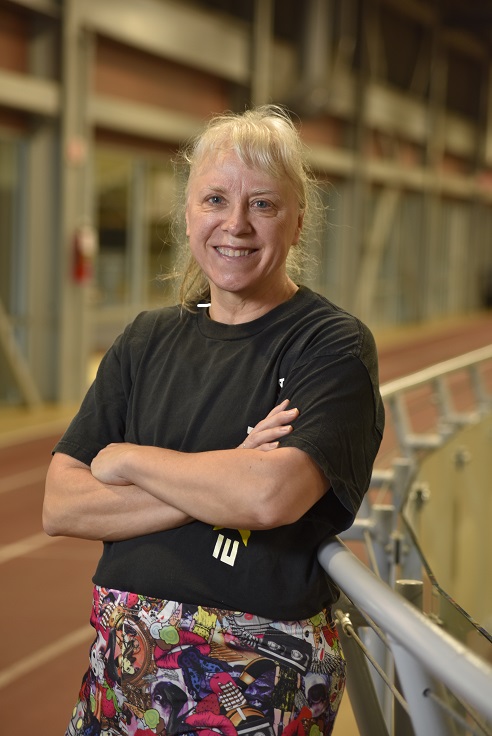
LaFayette-Boyd’s training partner Selina Coward. (Photo by Trevor Hopkin)
“We're fierce competitors on the track, but if I beat her tomorrow she would hug me the same as if she beat me today,” says Coward.
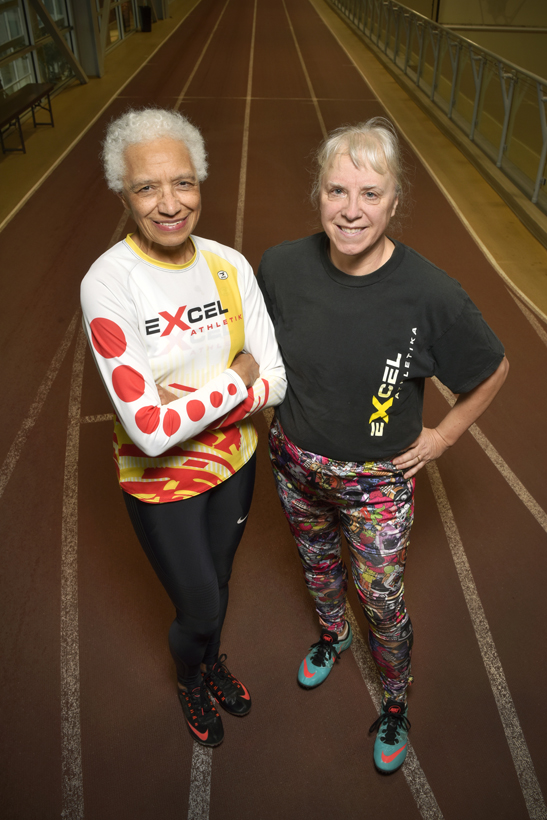
LaFayette-Boyd and Coward photographed on the University of Regina track. (Photo by Trevor Hopkin)
They spend at least three days each week together, 10 months of the year. Coward still marvels at LaFayette-Boyd’s character – never hesitating to loan her shotput shoes to a stranger or lend a shoulder to Coward, whose husband is suffering complications from a stroke.
“We're fierce competitors on the track, but if I beat her tomorrow she would hug me the same as if she beat me today,” says Coward.
LaFayette-Boyd grew up on a farm near McGee, Saskatchewan with seven siblings. Her job was to pick weeds and gather eggs. There was no running water. She attended a one-room schoolhouse named Oskaloosa, like her grandad’s hometown in Iowa. He came to Saskatchewan in 1906.
The LaFayettes were the only African-Canadian family in the area. She says that’s just how it was, and doesn’t recall overt experiences of racism. However, there are moments that linger in her mind, like being the only one not invited to a birthday party. She learned early to ignore cruel words.
“You can’t harass me because I’ll just dismiss you,” she says.
The family lived in Rosetown for a short time, then moved to Regina in 1956 after LaFayette-Boyd’s mother died of cancer. Unbeknownst to her at the time, her new Grade 9 teacher warned classmates to be nice to her – she was the only black girl at school. LaFayette-Boyd experienced more overt racism in the U.S. when she lived there with her first husband Lester Dodd, who served in the Air Force. Even the African-Americans treated her like an “other.”
“I looked like them; I didn’t speak like them,” she says.
LaFayette-Boyd holds the world record in the indoor 200 metres, three Canadian outdoor age-group records in the 4x100 metres, 4x400 metres and 4x800 metres relays, and two in the indoor 4x200 metres relay.
(Photo courtesy of Carol LaFayette-Boyd)
LaFayette-Boyd is constantly on the move but she’s never been too busy for others. That was always evident throughout her decades-long social work career. Her unconventional approach made her unforgettable and as much of a star in the social work realm as she is today on the track or in the field.
She served hundreds of children during her 33 years as a social worker, supervisor and trainer; some 200 families as a financial worker; 40 as a family services worker; and 12 in the Special Foster Home Program.
Unfortunately, in her line of work, she saw countless broken families caught up in cycles of abuse, neglect and addiction. Forever the optimist, LaFayette-Boyd felt it was most important to keep families together.
“There were always alternatives to splitting families,” she says. “You have to believe that people can change and you have to believe people want to do the right thing.”
LaFayette-Boyd not only visited families in their homes, but also spent time working in institutions. She worked as a psychiatric nurse at the Weyburn Hospital. As a social worker, she covered for striking workers at Saskatoon’s youth detention facility. The youth at the facility loved her, but it was an unimaginable experience with boys peeing from the rafters and girls cutting themselves. They’d plead for her: “Kokom LaFayette-Boyd, come. We’re dying, we’re dying.”
Starting in 1996 she began working at Regina’s Paul Dojack Youth Centre, a facility that serves at-risk young people. LaFayette-Boyd left her mark on Dojack as it did on her. While at Dojack, she preached dignity and respect, bragged about doing more pushups than the youth, and found little need for the “WRAP”, a control device with a shoulder harness, ankle bindings and leg restraints used to subdue residents.
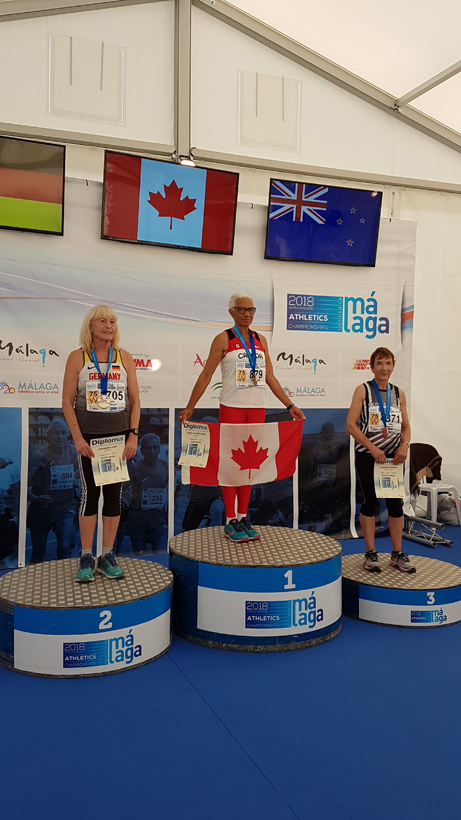
LaFayette-Boyd stands atop the podium during the 2018 World Masters Athletics Championships in Malaga, Spain. (Photo courtesy of Carol LaFayette-Boyd)
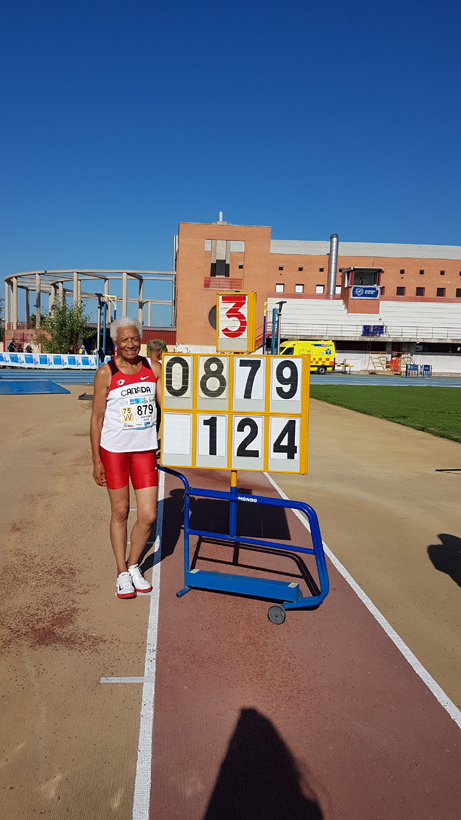
Last year, LaFayette-Boyd set a new world record in her age category for high jump at the 2018 World Masters Athletics Championships in Malaga, Spain. (Photo courtesy of Carol LaFayette-Boyd)
LaFayette-Boyd is competitive. And while she doesn’t like to lose, she’s not defeated by loss. Afterall, she’s seen more than her share of it in her life.
Cruel twists of fate decimated LaFayette-Boyd’s immediate family. Her daughter Jackie died of cancer in 2013. LaFayette-Boyd believed her daughter was in the clear but her husband’s words haunt her to this day: “She’s gone.”
Then it got worse. The next year LaFayette-Boyd lost her son.
She dealt with the anguish of losing two children with the help of God and her husband Lem. She didn’t know she was about to lose him, too.
Lem was also a social worker. They were comfortable together and married in 1984. He fell ill in 2015. A first doctor gave him iron pills. A second doctor gave him the truth: the growths on his lungs could be treated; the pancreatic cancer was terminal.
“Okay doc, how many years have I got?” Lem asked. “Weeks to months,” was the response. Thirty-three days later he died.
LaFayette-Boyd was able to move on and today, in her typical optimistic way, finds a cheery viewpoint. “They’re [her passed family members] up there, cheering me on,” she says.
LaFayette-Boyd starts her day in bed reading Psalm 91 – a psalm of protection from her King James Bible. In a curious ironic turn, she also flips through her husband Lem’s Twenty-Four Hours a Day, an Alcoholics Anonymous book that guided her late husband’s day-to-day life. She leaves bed for a stationary bike in the basement where she reads another chapter or two in the Bible.
After biking, she flips on CNN and hops on the elliptical. Sometimes she bounces on her trampoline. Back upstairs, she turns on a televangelist while she stretches. She says his message is about walking in love. That’s how she practised psychiatric nursing and social work. It’s how she moves through life now as a widow, a friend and an avid athlete.
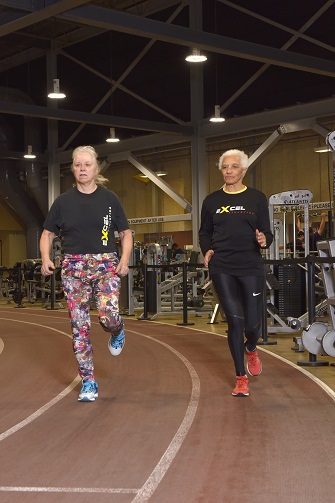
Coward and LaFayette-Boyd spend at least three days each week together, ten months of the year. Coward says the two are "joined at the hip." (Photo by Trevor Hopkin)
LaFayette-Boyd was able to move on and today, in her typical optimistic way, finds a cheery viewpoint.
LaFayette-Boyd loves her family – she revels in the company of her grandchildren and other relatives. She’s devoted much of her free time to genealogy. Beaming, she says she’s a descendant of James Armistead LaFayette, a slave famous for infiltrating British intelligence during the American Revolutionary War.
Her resolve has helped her through all aspects of her life, including athletics. When asked about being named 2018 World Masters Athletics Female Athlete of the Year, she pauses. A melancholic shadow passes over her thin face as she considers the question.
“I don’t know how to explain it,” she says softly. “I’m pleased, but it doesn't mean as much because my family … ,” she drifts off.
Her glasses reflect the warm lamp-glow as she uncrosses her arms and turns toward a photo of her daughter, son and husband.
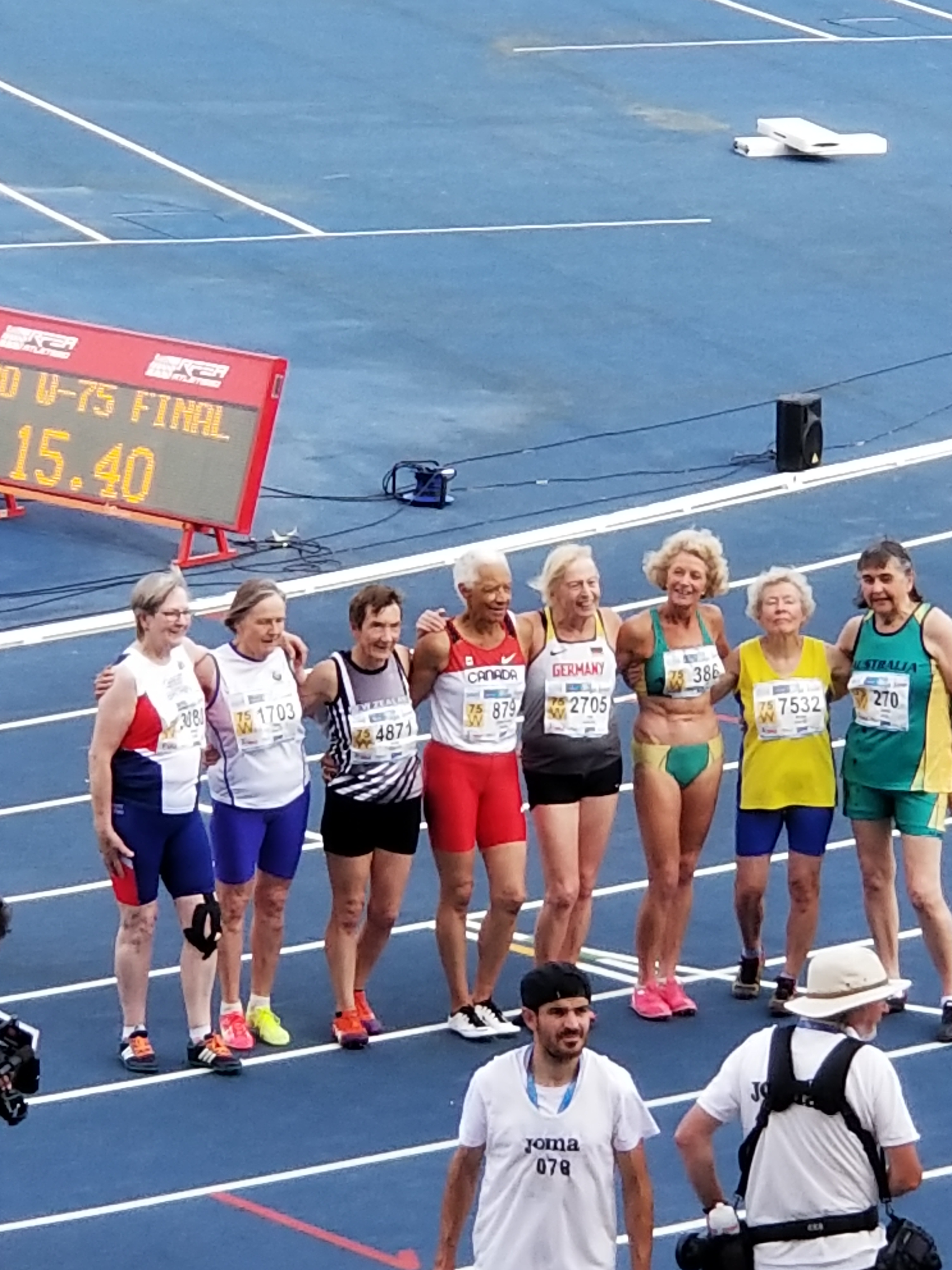
LaFayette-Boyd stands with her fellow competitors after she set a new record for her age in the 100 metres at the 2018 World Masters Athletics Championships in Malaga, Spain. (Photo courtesy of Carol LaFayette-Boyd)
She breaths deeply and the corners of her mouth rise.
“I’ve reached the top and now I can just relax.”
But for LaFayette-Boyd, relaxation doesn’t mean throwing in the towel.
“I’m in it until 100,” she says.
[post_title] => Running down a dream
[post_excerpt] => Carol LaFayette-Boyd has enjoyed the heights of individual accomplishment. She has also known the depths of personal tragedy. She takes both in stride. In fact, it’s her strides that have made her a global track and field legend. Last year, for instance, after several gold medals and world records, the 76-year-old was named Female Athlete of the Year by World Masters Athletics.
[post_status] => publish
[comment_status] => open
[ping_status] => open
[post_password] =>
[post_name] => running-down-a-dream
[to_ping] =>
[pinged] =>
[post_modified] => 2019-06-05 17:25:31
[post_modified_gmt] => 2019-06-05 23:25:31
[post_content_filtered] =>
[post_parent] => 0
[guid] => https://www.degreesmagazine.ca/?p=2936
[menu_order] => 0
[post_type] => post
[post_mime_type] =>
[comment_count] => 0
[filter] => raw
)




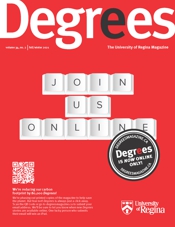

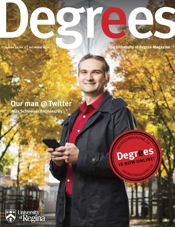


 Becker and one of her strongest supports, her mother Heather Getz. (Photo by Trevor Hopkin)
Becker and one of her strongest supports, her mother Heather Getz. (Photo by Trevor Hopkin)
 Becker and her fiancé, Sebastian Wolfmueller, take a break from studying. (Photo by Trevor Hopkin)
Becker and her fiancé, Sebastian Wolfmueller, take a break from studying. (Photo by Trevor Hopkin)
 Laura Ambrose, Biology instructor, Luther College. (Photo by Trevor Hopkin)
Laura Ambrose, Biology instructor, Luther College. (Photo by Trevor Hopkin)
 As of the time of the writing of the story, Becker was one class shy of earning her degree. (Photo by Trevor Hopkin)
As of the time of the writing of the story, Becker was one class shy of earning her degree. (Photo by Trevor Hopkin)
 Becker, a self-taught artist, has been seriously painting for a couple years. Her artwork not only helps in her recovery but she sells much of her output. (Photo by Trevor Hopkin)
Becker, a self-taught artist, has been seriously painting for a couple years. Her artwork not only helps in her recovery but she sells much of her output. (Photo by Trevor Hopkin)
 Becker’s art has helped her recovery as by engaging her fine motor skills and giving her another way to communicate. (Photo by Trevor Hopkin)
Becker’s art has helped her recovery as by engaging her fine motor skills and giving her another way to communicate. (Photo by Trevor Hopkin)
 Glenda James, executive director of the Saskatchewan Brain Injury Association. (Photo by Trevor Hopkin)
Glenda James, executive director of the Saskatchewan Brain Injury Association. (Photo by Trevor Hopkin)
 LaFayette-Boyd’s training partner Selina Coward. (Photo by Trevor Hopkin)
LaFayette-Boyd’s training partner Selina Coward. (Photo by Trevor Hopkin)
 LaFayette-Boyd and Coward photographed on the University of Regina track. (Photo by Trevor Hopkin)
LaFayette-Boyd and Coward photographed on the University of Regina track. (Photo by Trevor Hopkin)
 LaFayette-Boyd stands atop the podium during the 2018 World Masters Athletics Championships in Malaga, Spain. (Photo courtesy of Carol LaFayette-Boyd)
LaFayette-Boyd stands atop the podium during the 2018 World Masters Athletics Championships in Malaga, Spain. (Photo courtesy of Carol LaFayette-Boyd)
 Last year, LaFayette-Boyd set a new world record in her age category for high jump at the 2018 World Masters Athletics Championships in Malaga, Spain. (Photo courtesy of Carol LaFayette-Boyd)
Last year, LaFayette-Boyd set a new world record in her age category for high jump at the 2018 World Masters Athletics Championships in Malaga, Spain. (Photo courtesy of Carol LaFayette-Boyd)
 Coward and LaFayette-Boyd spend at least three days each week together, ten months of the year. Coward says the two are "joined at the hip." (Photo by Trevor Hopkin)
Coward and LaFayette-Boyd spend at least three days each week together, ten months of the year. Coward says the two are "joined at the hip." (Photo by Trevor Hopkin)
 LaFayette-Boyd stands with her fellow competitors after she set a new record for her age in the 100 metres at the 2018 World Masters Athletics Championships in Malaga, Spain. (Photo courtesy of Carol LaFayette-Boyd)
LaFayette-Boyd stands with her fellow competitors after she set a new record for her age in the 100 metres at the 2018 World Masters Athletics Championships in Malaga, Spain. (Photo courtesy of Carol LaFayette-Boyd)